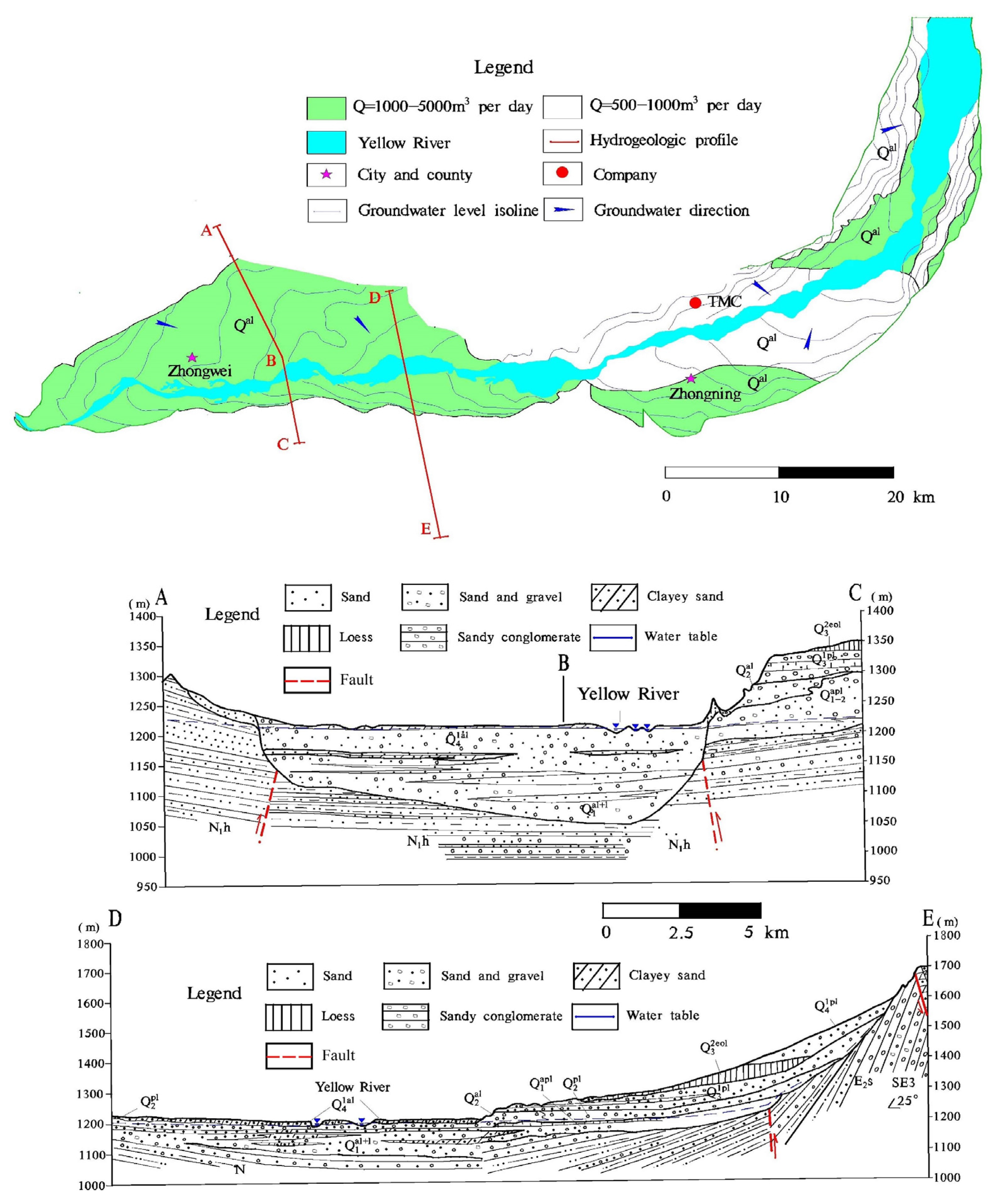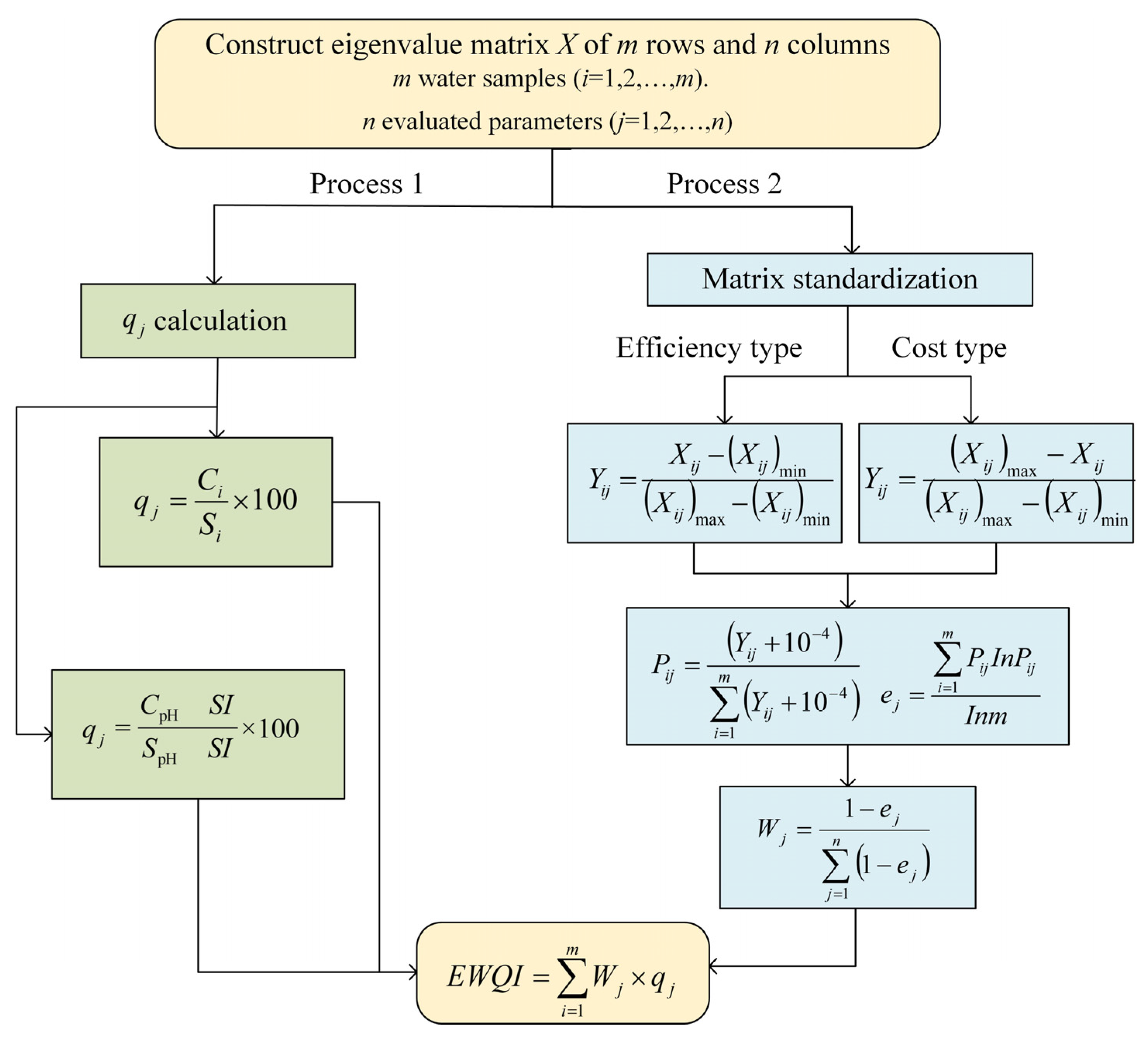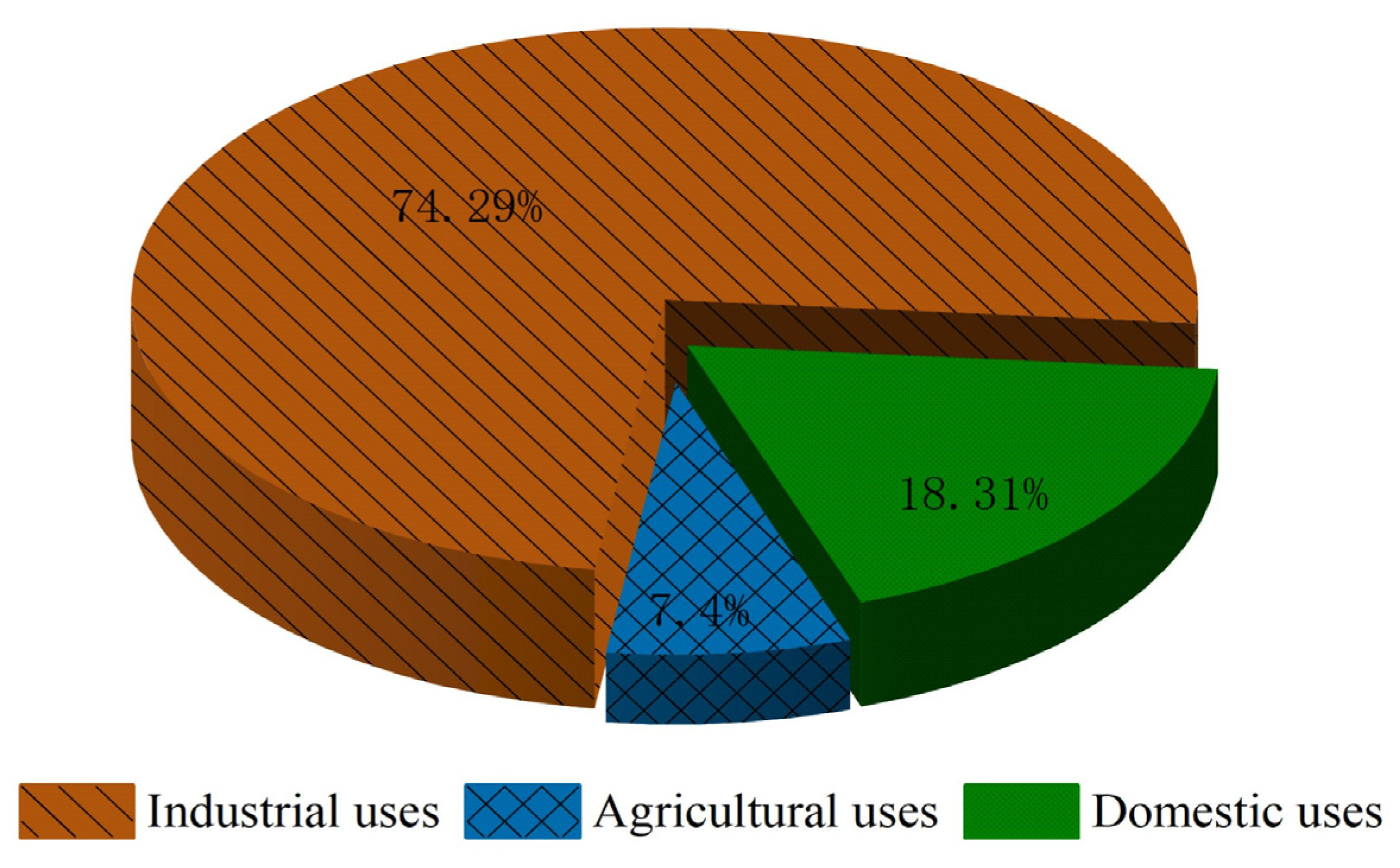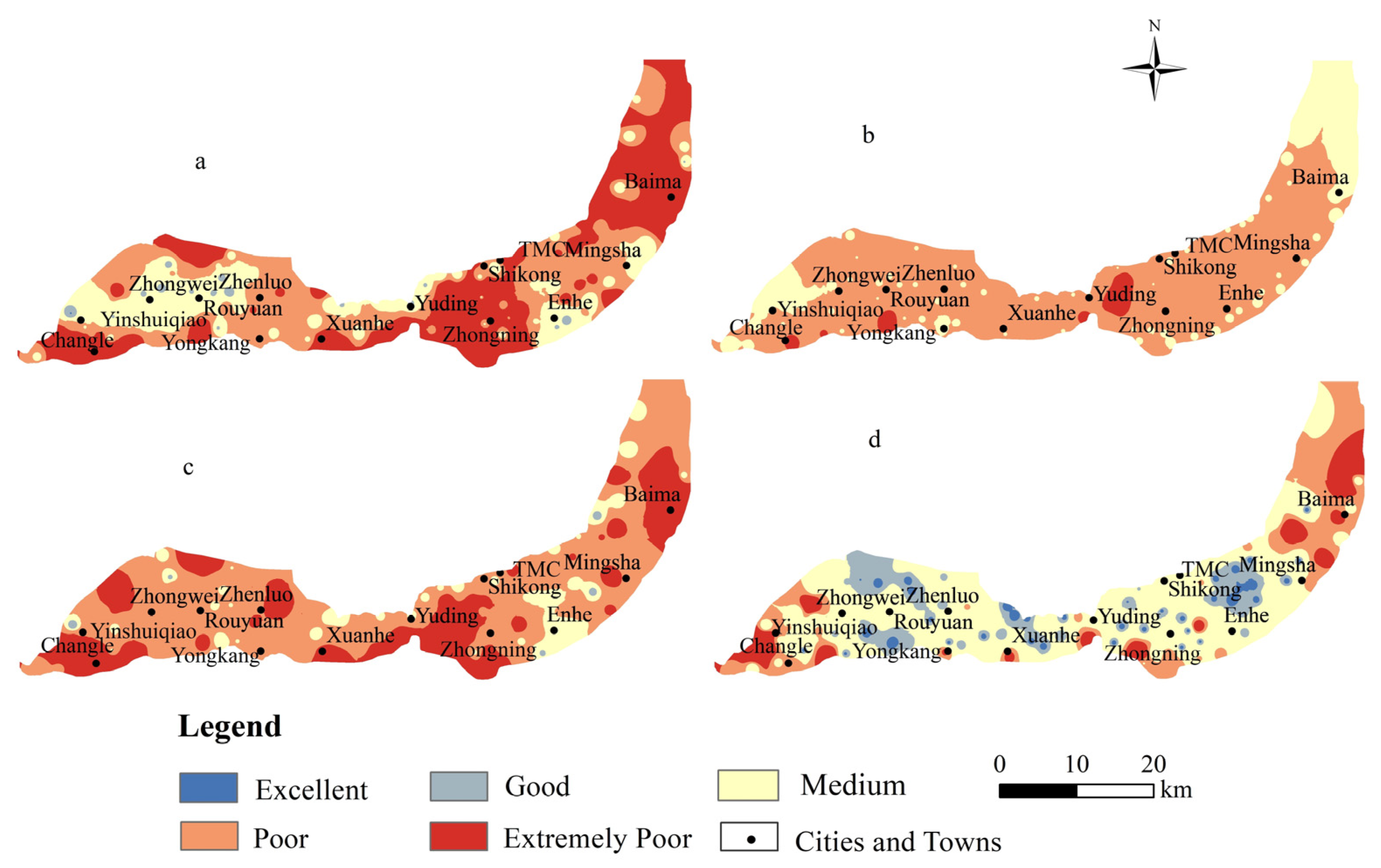Estimation of Groundwater Recharge and Assessment of Groundwater Quality in the Weining Plain, China
Abstract
1. Introduction
2. Materials and Methods
2.1. Study Area
2.1.1. Location and Climate
2.1.2. Hydrogeological Settings
2.2. Data Collection and Analysis
2.3. Estimation Method for Groundwater Recharge
2.3.1. Water Balance Analysis
2.3.2. End Member Mixing Analysis (EMMA)
2.4. Methods for Drinking Water Quality Assessment
2.5. Methods for Irrigation Water Quality Assessment
2.6. Methods for Industrial Water Quality Assessment
3. Results and Discussion
3.1. Status of Groundwater Utilization in the Weining Plain
3.2. Estimation of Groundwater Recharge
3.2.1. Groundwater Recharge and Discharge Status
3.2.2. Estimation of Contribution Ratio of End Members
3.3. Assessment of Groundwater Quality
3.3.1. Statistical Analysis and Spatial Distribution of Water Quality Parameters
3.3.2. Groundwater Quality for Drinking Purposes
3.3.3. Groundwater Suitability for Irrigation
3.3.4. Suitability for Industrial Uses
3.4. Groundwater Protection Strategies
4. Conclusions
- (1)
- The source of groundwater recharge in the Weining Plain is mainly Yellow River water, accounting for over half of the total recharge. However, compared with the groundwater budget calculation, the proportion of Yellow River water recharge derived from the end member mixing method is small (67.42% for groundwater budget calculation and 51.99% from the end member mixing method), the proportion of atmospheric precipitation recharge is large (7.80% and 20.92%, respectively). This may be due to the fact that the method neglects the interconversion and mutual influence between different recharge sources.
- (2)
- The results of EWQI show that good, moderate, poor, and extremely poor water quality account for 2.76%, 51.03%, 31.03%, and 15.18% of the total evaluated water samples, respectively. The overall groundwater quality in plain areas is poor. The areas in the south of Rouyuan, Changle, and eastern Yuding displayed extremely poor groundwater quality and need to be treated as drinking water. Groundwater quality in the Weining Plain basically meets the irrigation water quality standards and will not cause serious saline-alkali damage. However, groundwater has a corrosive effect on the boilers in the research area, and there is a high risk of scaling and foaming. The IndWQI method shows that only 12.41% of the water samples possess good water quality for industrial use.
Author Contributions
Funding
Data Availability Statement
Conflicts of Interest
References
- Masmoudi, T.; Benakcha, M.; Abdennour, M.A.; Bouzekri, A.; Amrane, A.; Alcala, F.J. Groundwater quality evaluation for drinking and agricultural purposes. A case study in semi-arid region (Zab El-gharbi SE-Algeria). Desalin. Water Treat. 2024, 319, 100476. [Google Scholar] [CrossRef]
- Omeka, M.E.; Egbueri, J.C.; Unigwe, C.O. Investigating the hydrogeochemistry, corrosivity and scaling tendencies of groundwater in an agrarian area (Nigeria) using graphical, indexical and statistical modelling. Arab. J. Geosci. 2022, 15, 1233. [Google Scholar] [CrossRef]
- Subba Rao, N.; Das, R.; Sahoo, H.K.; Gugulothu, S. Hydrochemical characterization and water quality perspectives for groundwater management for urban development. Groundw. Sustain. Dev. 2024, 24, 101071. [Google Scholar] [CrossRef]
- Wagh, V.; Mukate, S.; Muley, A.; Kadam, A.; Panaskar, D.; Varade, A. Study of groundwater contamination and drinking suitability in basaltic terrain of Maharashtra, India through PIG and multivariate statistical techniques. J. Water Supply Res. Technol. Aqua 2020, 69, 398–414. [Google Scholar] [CrossRef]
- Jasechko, S.; Seybold, H.; Perrone, D.; Fan, Y.; Shamsudduha, M.; Taylor, R.G.; Fallatah, O. Rapid groundwater decline and some cases of recovery in aquifers globally. Nature 2024, 625, 715–721. [Google Scholar] [CrossRef] [PubMed]
- Cheng, W.J.; Feng, Q.; Xi, H.Y.; Yin, X.; Cheng, L.; Sindikubwabo, C.; Zhang, B.; Chen, Y.; Zhao, X. Modeling and assessing the impacts of climate change on groundwater recharge in endorheic basins of Northwest China. Sci. Total Environ. 2024, 918, 170829. [Google Scholar] [CrossRef]
- Ashraf, S.; Ali, M.; Shrestha, S.; Hafeez, M.A.; Moiz, A.; Sheikh, Z.A. Impacts of climate and land-use change on groundwater recharge in the semi-arid lower Ravi River basin, Pakistan. Groundwater Sustain. Dev. 2022, 17, 100743. [Google Scholar] [CrossRef]
- Green, T.R.; Taniguchi, M.; Kooi, H.; Gurdak, J.J.; Allen, D.M.; Hiscock, K.M.; Treidel, H.; Aureli, A. Beneath the surface of global change: Impacts of climate change on groundwater. J. Hydrol. 2011, 405, 532–560. [Google Scholar] [CrossRef]
- Cook, P.G.; Dogramaci, S. Estimating Recharge from Recirculated Groundwater with Dissolved Gases: An End-Member Mixing Analysis. Water Resour. Res. 2019, 55, 5468–5486. [Google Scholar] [CrossRef]
- Nina, K.; Christoph, K.; Adriana, B.; Christos, C. Groundwater recharge estimation in Mediterranean mountain environments by isotope profiles–Partitioning of macropore and matrix flow. J. Hydrol. 2024, 637, 131352. [Google Scholar] [CrossRef]
- Chuko, F.W.; Abdissa, A.G. Impact of land-use dynamics and climate change scenarios on groundwater recharge in the case of Anger watershed, Ethiopia. Heliyon 2023, 9, e18467. [Google Scholar] [CrossRef] [PubMed]
- Shen, Z.; Zhang, Q.; Chen, D. Varying effects of mining development on ecological conditions and groundwater storage in dry region in Inner Mongolia of China. J. Hydrol. 2021, 597, 125759. [Google Scholar] [CrossRef]
- Post, D.A.; Crosbie, R.S.; Viney, N.R.; Peeters, L.J.M.; Zhang, Y.Q.; Herron, N.F.; Wilkins, A.; Janardhanan, S.; Karim, F.; Aryal, S.K.; et al. Impacts of coal mining and coal seam gas extraction on groundwater and surface water. J. Hydrol. 2020, 591, 125281. [Google Scholar] [CrossRef]
- Foster, S.S.D.; Chilton, P.J. Groundwater: The processes and global significance of aquifer degradation. Philos. Trans. R. Soc. London. Ser. B Biol. Sci. 2003, 358, 1957–1972. [Google Scholar] [CrossRef] [PubMed]
- Wang, Y.H.; Li, P.Y. Appraisal of shallow groundwater quality with human health risk assessment in different seasons in rural areas of the Guanzhong Plain (China). Environ. Res. 2022, 207, 112210. [Google Scholar] [CrossRef] [PubMed]
- Subba Rao, N.; Sunitha, B.; Adimalla, N.; Chaudhary, M. Quality criteria for groundwater use from a rural part of Wanaparthy District, Telangana State, India, through ionic spatial distribution (ISD), entropy water quality index (EWQI) and principal component analysis (PCA). Environ. Geochem. Health 2020, 42, 579–599. [Google Scholar] [CrossRef]
- He, S.; Li, P.Y.; Su, F.M.; Wang, D.; Ren, X.F. Identification and apportionment of shallow groundwater nitrate pollution in Weining Plain, northwest China, using hydrochemical indices, nitrate stable isotopes, and the new Bayesian stable isotope mixing model (MixSIAR). Environ. Pollut. 2022, 298, 118852. [Google Scholar] [CrossRef] [PubMed]
- Han, Q.Q. Analysis of Hydrogeological Conditions and Groundwater Chemical Characteristics in Weining Plain, Ningxia. Sci. Technol. Inf. 2012, 9, 444–459. (In Chinese) [Google Scholar]
- Liu, L.N.; Wu, J.H.; He, S.; Wang, L. Occurrence and Distribution of Groundwater Fluoride and Manganese in the Weining Plain (China) and Their Probabilistic Health Risk Quantification. Expo. Health 2022, 14, 263–279. [Google Scholar] [CrossRef]
- Li, P.Y. Research on Groundwater Environment Under the Influence of Human Activities: A Case Study of Weining Plain in Ningxia. Ph.D. Thesis, Chang’an University, Xi’an, China, 2014. (In Chinese). [Google Scholar]
- APHA. Standard Methods for the Examination of Water and Wastewater, 21st ed.; American Public Health Association: Washington, DC, USA, 2005. [Google Scholar]
- GB/T5750-2006; Standard Examination Methods for Drinking Water. Ministry of Health of PRC, Standardization Administration of PRC; Standards Press of China: Beijing, China, 2006. (In Chinese)
- IAEA. Vienna Standard Mean Ocean Water (V-SMOW): Definition and Distribution; International Atomic Energy Agency: Vienna, Austria, 1968. [Google Scholar]
- Christophersen, N.; Neal, C.; Hooper, R.P.; Vogt, R.D.; Andersen, S. Modelling streamwater chemistry as a mixture of soilwater end members—A step towards second-generation acidification models. J. Hydrol. 1990, 116, 307–320. [Google Scholar] [CrossRef]
- Hooper. Modeling Streamwater Chemistry as a Mixture of Soilwater End member-An Application to the Panola Mountain Cachmenrt, GEORGIA, U.S.A. J. Hydrol. 1990, 116, 321–343. [Google Scholar] [CrossRef]
- Peng, T.R.; Huang, C.C.; Chen, J.E.; Zhan, W.J.; Chiang, W.; Chang, L.C. Evaluating the relative importance of groundwater recharge sources in a subtropical alluvial plain using tracer-based ternary end member mixing analysis (EMMA). Water Res. Manag. 2016, 30, 3861–3878. [Google Scholar] [CrossRef]
- Qiao, J.; Zhu, Y.; Jia, X.; Shao, M.; Niu, X.; Liu, J. Distributions of arsenic and other heavy metals, and health risk assessments for groundwater in the Guanzhong plain region of China. Environ. Res. 2020, 181, 108957. [Google Scholar] [CrossRef] [PubMed]
- Wang, D.; Wu, J.H.; Wang, Y.H.; Ji, Y.J. Finding High-Quality Groundwater Resources to Reduce the Hydatidosis Incidence in the Shiqu County of Sichuan Province, China: Analysis, Assessment, and Management. Expo. Health 2020, 12, 307–322. [Google Scholar] [CrossRef]
- Adimalla, N.; Venkatayogi, S. Geochemical characterization and evaluation of groundwater suitability for domestic and agricultural utility in semi-arid region of Basara, Telangana State, South India. Appl. Water Sci. 2018, 8, 44. [Google Scholar] [CrossRef]
- Pradeep, T.; Sampathkumar, V.; Nallasamy, J.L.; Shanmugamoorthy, M.; Sudalaimuthu, G.; Veerasamy, S.; Periyasamy, M.; Murugasamy, M.V. Evaluation of groundwater quality for irrigation purposes in hard rock terrain of Southern India using water quality indices modelling. Desalin. Water Treat. 2024, 318, 100397. [Google Scholar] [CrossRef]
- Ragunath, H.M. Groundwater; Wiley: New Delhi, India, 1987. [Google Scholar]
- Doneen, L.D. Notes on Water Quality in Agriculture; Water Science and Engineering Paper 4001; Department of Water Sciences and Engineering, University of California: Davis, CA, USA, 1964. [Google Scholar]
- Li, Y.H.; Zhou, J.Z.; Wang, G.R.; Ma, K.; Zhang, Z.P. Analysis of the Development Trends of Industrial Water Treatment Technology. Front. Environ. Prot. 2021, 11, 135–141. (In Chinese) [Google Scholar] [CrossRef]
- Liu, Z.C.; Li, G.H.; Zhu, K. Hydrogeology of Water Supply, 3rd ed.; China Architecture and Building Press: Beijing, China, 1998. [Google Scholar]
- Nsabimana, A.; Li, P.Y. Hydrogeochemical characterization and appraisal of groundwater quality for industrial purpose using a novel industrial water quality index (IndWQI) in the Guanzhong Basin, China. Geochemistry 2023, 83, 125922. [Google Scholar] [CrossRef]
- GB/T 1576-2018; National Standards of the People’s Republic of China for Industrial Boiler Water Quality. Ministry of Environmental Protection of the P.R. China; China Environmental Science Press: Beijing, China, 2018. (In Chinese)
- Piyathilake, I.D.U.H.; Ranaweera, L.V.; Udayakumara, E.P.N.; Gunatilake, S.K.; Dissanayake, C.B. Assessing groundwater quality using the Water Quality Index (WQI) and GIS in the Uva Province, Sri Lanka. Appl. Water Sci. 2022, 12, 72. [Google Scholar] [CrossRef]
- Mangestiyono, W.; Sutrisno, S.; Mrihardjono, J. Pipe Blockage Prediction of Shell and Tube Heat Exchanger under Linear and Cross Flow Operation. Mater. Today Proc. 2019, 13, 132–136. [Google Scholar] [CrossRef]
- Shah, M.; Patel, H.; Viramgama, P.; Varanava, D.; Maheshwari, D. Characterization and assessment of groundwater aquifers from Bakreshwar and Tantloi geothermal fields for its industrial applications. Groundwater Sustain. Dev. 2021, 12, 100535. [Google Scholar] [CrossRef]
- He, S. Research on the Response of Groundwater Environment in Weining Plain to Climate Factors and Changes in Land Use/Cover Patterns; Chang’an University: Xi’an, China, 2022. (In Chinese) [Google Scholar]
- Wang, F.G.; Wang, Y.H.; Jiang, M.; Wang, H.; Pan, H.L.; Wu, M.J.; Cao, Y.Q. Water circulation condition and calculation of water balance in Tianchi Lake of the Changbai Mountains. Sci. Geogr. Sin. 2023, 43, 1291–1298. [Google Scholar] [CrossRef]
- Cartwright, I.; Cendón, D.; Currell, M.; Meredith, K. A review of radioactive isotopes and other residence time traces in understanding groundwater recharge: Possibilities, challenges, and limitations. J. Hydrol. 2017, 555, 797–811. [Google Scholar] [CrossRef]
- Dubois, E.; Larocque, M.; Brunner, P. Impact of land cover changes on Long-Term Regional-Scale groundwater recharge simulation in cold and humid climates. Hydrol. Process. 2023, 37, e14810. [Google Scholar] [CrossRef]
- GB5749-2006; Standards for Drinking Water Quality. Ministry of Health of PRC, Standardization Administration of PRC; Standards Press of China: Beijing, China, 2006. (In Chinese)
- Jiang, C.L.; Cheng, L.L.; Li, C.; Zheng, L.G. A hydrochemical and multi-isotopic study of groundwater sulfate origin and contribution in the coal mining area. Ecotoxicol. Environ. Saf. 2022, 248, 114286. [Google Scholar] [CrossRef] [PubMed]
- WHO. Guidelines for Drinking Water Quality. 2011. Available online: https://iris.who.int/handle/10665/44584 (accessed on 24 January 2025).
- Chen, J.; Wu, H.; Qian, H.; Gao, Y.Y. Assessing nitrate and fluoride contaminants in drinking water and their health risk of rural residents living in a semiarid region of Northwest China. Expo. Health 2017, 9, 183–195. [Google Scholar] [CrossRef]
- Zhang, Y.; Xu, M.; Li, X.; Qi, J.; Zhang, Q.; Guo, J. Hydrochemical characteristics and quality assessment of groundwater in the Yinchuan Plain, China. Environ. Earth Sci. 2020, 79, 127. [Google Scholar] [CrossRef]
- Benaissa, M.; Gueroui, Y.; Guettaf, M.; Boudalia, S.; Bousbia, A.; Ouartsi, A.; Maoui, A. Hydrochemical characterization and evaluation of irrigation water quality using indexing approaches, multivariate analysis, and GIS techniques in K’sob Valley, Algeria. J. Afr. Earth Sci. 2024, 219, 105385. [Google Scholar] [CrossRef]
- Wilcox, L.V. The Quality of Water for Irrigation Use; US Dept of Agriculture Tech Bull 1962: Washington, DC, USA, 1948. [Google Scholar]
- United States Salinity Laboratory (USSL). Diagnosis and Improvement of Saline and Alkali Soils. In Agriculture Handbook 60; US Dept of Agriculture (USDA): Washington, DC, USA, 1954; pp. 69–81. [Google Scholar]
- Walid, M.; Saber, E.; Hussam, J. Assessment of Scale Removal by Chemical and Underbalance Mechanical Treatments. In Proceedings of the International Conference on Industrial Engineering and Operations Management, Rabat, Morocco, 11–13 April 2017; Available online: https://ieomsociety.org/ieom2017/papers/329.pdf (accessed on 24 January 2025).
- Zhu, Y.J. Research on the Harm of Poor Water Quality to Boilers and Boiler Water Treatment Measures, China. Equip. Eng. 2020, 5, 144–145. [Google Scholar]
- Chaabane, S.; Riahi, K.; Hamrouni, H.; Thayer, B.B. Suitability assessment of grey water quality treated with an upflow-downflow siliceous sand/marble waste filtration system for agricultural and industrial purposes. Environ. Sci. Pollut. Res. 2017, 24, 9870–9885. [Google Scholar] [CrossRef] [PubMed]
- Wu, H.; Chen, J.; Qian, H.; Zhang, X.D. Chemical Characteristics and Quality Assessment of Groundwater of Exploited Aquifers in Beijiao Water Source of Yinchuan, China: A Case Study for Drinking, Irrigation, and Industrial Purposes. J. Chem. 2015, 2015, 726340. [Google Scholar] [CrossRef]
- Li, X.Y.; Gao, Y.Y.; Qian, H.; Wu, H. Groundwater vulnerability and contamination risk assessment of the Weining Plain, using a modified DRASTIC model and quantized pollution loading method. Arab. J. Geosci. 2017, 10, 469. [Google Scholar] [CrossRef]
- Ma, B.Q.; Huang, T.M.; Li, J.; Li, Z.B.; Yin, L.; Zhang, F.; Pang, Z. Tracing nitrate source and transformation in a semiarid loess aquifer with the thick unsaturated zone. Catena 2021, 198, 105045. [Google Scholar] [CrossRef]
- Mohammed, Y.J.; Mustapha, N.; Soumia, A. Impact of overexploitation of groundwater along the irrigated perimeter of Tadla, Oum Errabia Basin, Morocco. Desalin. Water Treat. 2020, 195, 201–212. [Google Scholar] [CrossRef]








| EWQI | Grade | Water Quality |
|---|---|---|
| <25 | Ⅰ | Excellent quality |
| 25–50 | Ⅱ | Good quality |
| 50–100 | Ⅲ | Medium quality |
| 100–150 | Ⅳ | Poor quality |
| >150 | Ⅴ | Very poor quality |
| SAR | TDS | Water Quality | RSC | %Na | PI | Water Quality |
|---|---|---|---|---|---|---|
| <10 | <2000 | Excellent | <1.25 | <30% | >75% | Suitable |
| 10–18 | <3000 | Good | 1.25–2.5 | 30–60% | 25–75% | Doubtful |
| 18–26 | <4000 | Medium | >2.5 | >60% | <25% | Unsuitable |
| >26 | >4000 | Poor |
| Scaling Effect | Corrosion | Foaming | |||||
|---|---|---|---|---|---|---|---|
| Total Scale (H0) | Hard Scale Coefficient (Ki) | Corrosion Coefficient (Kc) | Foaming Coefficient (F) | ||||
| Classification | Water Quality Type | Classification | Water Quality Type | Classification | Water Quality Type | Classification | Water Quality Type |
| <125 | Water with very low scale | <0.25 | Water with soft scale | >0 | Corrosive water | F < 60 | No foaming |
| 125~250 | Water with low scale | 0.25~0.5 | Water with soft to hard scale | <0, Kc + 0.0503Ca2+ > 0 | Semi-corrosive water | 60~200 | Marginal |
| 250~500 | Water with a lot of scale | >0.5 | Water with hard scale | <0, Kc + 0.0503Ca2+ < 0 | Non-corrosive water | F > 200 | Foaming |
| >500 | Water with a lot of limescale | ||||||
| Locations | No. of Wells | Exploitation (×104 m3/Year) | Proportion (%) |
|---|---|---|---|
| Zhongwei water source | 8 | 463.50 | 8.26 |
| Zhongning water source | 9 | 360.00 | 6.41 |
| Zhongwei railway station | 3 | 91.25 | 1.63 |
| Zhongwei Hospital | 1 | 10.95 | 0.20 |
| Yinghai Industrial Park | 3 | 219.00 | 3.90 |
| Other industrial enterprises | 107 | 4469.56 | 79.61 |
| Total | 131 | 5614.26 | 100 |
| Water Balance Factors | Quantity (108 m3/a) | Proportion (%) |
|---|---|---|
| Atmospheric precipitation infiltration recharge | 0.2569 | 7.80 |
| Agricultural irrigation infiltration recharge | 1.3271 | 40.31 |
| Canal system leakage recharge | 0.8926 | 27.11 |
| Lateral runoff recharge | 0.8157 | 24.78 |
| Total recharge | 3.2923 | 100 |
| Submarine evaporation discharge | 0.5504 | 17.23 |
| Lateral runoff discharge | 0.7185 | 22.49 |
| Drainage ditch discharge | 1.1963 | 37.46 |
| Artificial mining discharge | 0.7289 | 22.82 |
| Total discharge | 3.1941 | 100 |
| Balance difference | 0.0982 | |
| Relative equilibrium difference (%) | 1.51 | |
| Statistics | pH | SO42− | Cl− | F− | TDS | TH | NH4-N |
|---|---|---|---|---|---|---|---|
| Unit | / | mg/L | mg/L | mg/L | mg/L | mg/L | mg/L |
| Min | 6.99 | 43.2 | 17.7 | 0.17 | 252 | 145 | 0.02 |
| Max | 8.18 | 2113 | 957 | 5.10 | 4280 | 2302 | 8.71 |
| Mean | 7.49 | 362.45 | 169.06 | 0.81 | 1156.42 | 604.4 | 0.11 |
| Permissible limit | 6.5–8.5 | 250 | 250 | 1 | 1000 | 450.00 | 0.20 |
| NSBL | 0 | 75 | 24 | 30 | 61 | 104 | 8 |
| RSBL (%) | 0.00 | 51.72 | 16.55 | 20.69 | 42.07 | 71.72 | 5.52 |
| Statistics | NO3-N | CODMn | NO2-N | Na | Mn | Pb | Cr6+ |
| Unit | mg/L | mg/L | mg/L | mg/L | mg/L | mg/L | mg/L |
| Min | 0.56 | 0.00 | 0.00 | 19.9 | 0.05 | 0.001 | 0.005 |
| Max | 179.06 | 4.16 | 1.40 | 996 | 4.20 | 0.009 | 0.016 |
| Mean | 14.52 | 1.12 | 0.04 | 159.46 | 0.405 | 0.0016 | 0.005 |
| Permissible limit | 20 | 3 | 0.02 | 200 | 0.1 | 0.05 | 0.05 |
| NSBL | 32 | 4 | 34 | 35 | 73 | 0 | 0 |
| RSBL (%) | 22.07 | 2.76 | 23.45 | 24.14 | 50.34 | 0.00 | 0.00 |
| Indicators | Classification | Number of Samples | Percentage |
|---|---|---|---|
| TDS | Excellent | 131 | 90.34% |
| Good | 11 | 7.59% | |
| Medium | 2 | 1.38% | |
| Poor | 1 | 0.69% | |
| SAR | Suitable | 145 | 100% |
| RSC | Suitable | 144 | 99.31% |
| Unsuitable | 1 | 0.69% | |
| Na% | Suitable | 65 | 44.83% |
| Doubtful | 75 | 51.72% | |
| Unsuitable | 5 | 3.45% | |
| PI | Suitable | 3 | 2.07% |
| Doubtful | 139 | 95.86% | |
| Unsuitable | 3 | 2.07% |
| Classifications | Number of Samples | Percentages |
|---|---|---|
| Excellent | 0 | 0% |
| Good | 18 | 12.41% |
| Poor | 62 | 42.76% |
| Extremely poor | 35 | 24.14% |
| Unsuitable | 30 | 20.69% |
Disclaimer/Publisher’s Note: The statements, opinions and data contained in all publications are solely those of the individual author(s) and contributor(s) and not of MDPI and/or the editor(s). MDPI and/or the editor(s) disclaim responsibility for any injury to people or property resulting from any ideas, methods, instructions or products referred to in the content. |
© 2025 by the authors. Licensee MDPI, Basel, Switzerland. This article is an open access article distributed under the terms and conditions of the Creative Commons Attribution (CC BY) license (https://creativecommons.org/licenses/by/4.0/).
Share and Cite
Gong, M.; Li, P.; Kong, J. Estimation of Groundwater Recharge and Assessment of Groundwater Quality in the Weining Plain, China. Water 2025, 17, 704. https://doi.org/10.3390/w17050704
Gong M, Li P, Kong J. Estimation of Groundwater Recharge and Assessment of Groundwater Quality in the Weining Plain, China. Water. 2025; 17(5):704. https://doi.org/10.3390/w17050704
Chicago/Turabian StyleGong, Mengyu, Peiyue Li, and Jiajia Kong. 2025. "Estimation of Groundwater Recharge and Assessment of Groundwater Quality in the Weining Plain, China" Water 17, no. 5: 704. https://doi.org/10.3390/w17050704
APA StyleGong, M., Li, P., & Kong, J. (2025). Estimation of Groundwater Recharge and Assessment of Groundwater Quality in the Weining Plain, China. Water, 17(5), 704. https://doi.org/10.3390/w17050704







